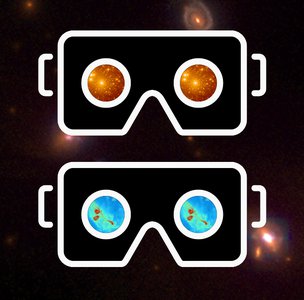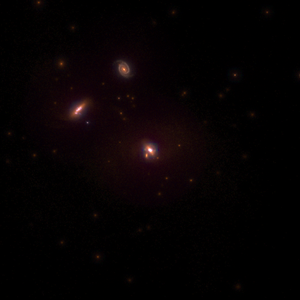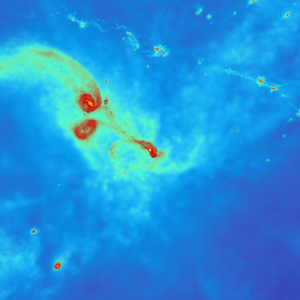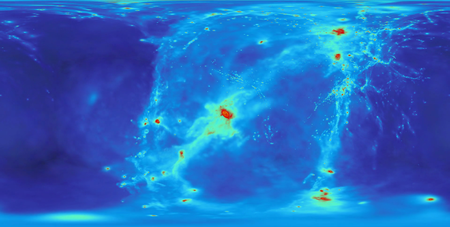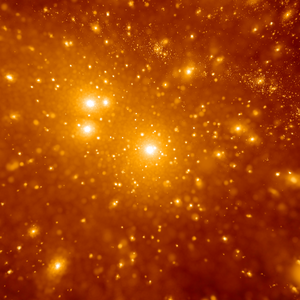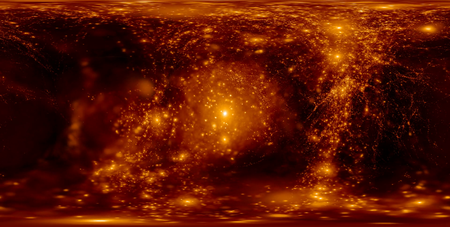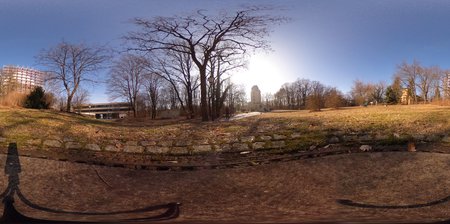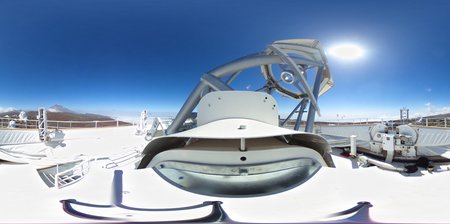Virtual Reality meets Astrophysics
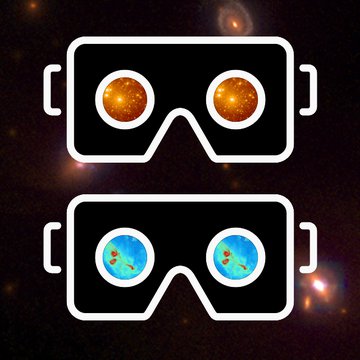
With virtual reality glasses, one can see the distribution of dark matter (top) and gas in the universe (below).
Credit: Arman Khalatyan/AIP; VR Icon: © subhanbaghirov / Fotolia; Photo montage: AIPThe Leibniz Institute for Astrophysics Potsdam (AIP) is launching a new Virtual Reality (VR) website. Offering 360 degree videos and panoramas, the new web portal vr.aip.de invites visitors to experience the cosmos and to take virtual tours through astronomical observatories. The website can be navigated either in VR mode, using a VR-headset, or via touch and click on any display. All media is based on scientific results, simulations from supercomputers, or images from telescopes and observatories.
Astrophysicists get their insights of the universe and its objects from analyzing huge amounts of data from observations and simulations of stars, galaxies and other cosmic objects. Elaborate visualization methods make these data tangible. The videos allow the user to go on a VR excursion through our local cosmic neighbourhood. Its appearance changes dramatically with the kind of objects that are visualized – for instance dark matter, gas or stars. Enigmatic dark matter dominates the cosmic large-scale structure. Stars and galaxies trace this structure. These three different views of the universe also demonstrate how real astronomical observations work, using different telescopes and instruments to decipher the different objects and building blocks of the universe.
“With simulations and VR we make the invisible visible,” says Arman Khalatyan, an AIP astrophysicist, IT specialist, the initiator and creator of the AIP VR website. He also produced the VR movies and most of the simulations that they are based on. “With simple VR headsets and free apps, VR technology can be used by everyone today. With our platform we now open the universe to everyone.”
Virtual tour to astronomical observatories
The second part of the website invites the visitors to a virtual tour through different astrophysical observatories that are linked to the AIP due to telescope or instrument collaborations. If interested in the sun, one could choose a tour to the “Observatorio del Teide”, for instance. This international observatory is located at 2,400 meters above sea level on the island of Tenerife. During a virtual tour of the campus one can enter and explore the dome of the solar telescope GREGOR or take a look at the other telescopes of the observatory. In the background one can see the Teide Mountain at 3,718 meter not so far away above the clouds. Fans of architecture may choose the tour to the Einstein Tower in nearby Potsdam. More observatories worldwide are planned to follow soon to extend the website experience.
“With this Virtual Reality project, we would like to tell stories about the universe and encourage the exploration of fascinating locations of astronomical research,“ explains Gabriele Schönherr, an astrophysicist, science communicator and co-initiator of the AIP VR project. “Modern astrophysical observations are an international effort. This thought becomes alive in Virtual Reality.”
Further information
Web portal: vr.aip.de
Science contact: Dr. Arman Khalatyan, Leibniz Institute for Astrophysics Potsdam, +49 331-7499 528, akhalatyan@aip.de
Media contact: Katrin Albaum, +49 331-7499 803, presse@aip.de
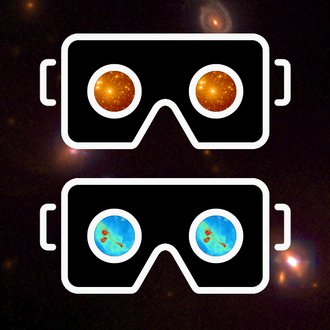
With virtual reality glasses, one can see the distribution of dark matter (top) and gas in the universe (below).
Credit: Arman Khalatyan/AIP; VR Icon: © subhanbaghirov / Fotolia; Photo montage: AIPThe Leibniz Institute for Astrophysics Potsdam (AIP) is launching a new Virtual Reality (VR) website. Offering 360 degree videos and panoramas, the new web portal vr.aip.de invites visitors to experience the cosmos and to take virtual tours through astronomical observatories. The website can be navigated either in VR mode, using a VR-headset, or via touch and click on any display. All media is based on scientific results, simulations from supercomputers, or images from telescopes and observatories.
Astrophysicists get their insights of the universe and its objects from analyzing huge amounts of data from observations and simulations of stars, galaxies and other cosmic objects. Elaborate visualization methods make these data tangible. The videos allow the user to go on a VR excursion through our local cosmic neighbourhood. Its appearance changes dramatically with the kind of objects that are visualized – for instance dark matter, gas or stars. Enigmatic dark matter dominates the cosmic large-scale structure. Stars and galaxies trace this structure. These three different views of the universe also demonstrate how real astronomical observations work, using different telescopes and instruments to decipher the different objects and building blocks of the universe.
“With simulations and VR we make the invisible visible,” says Arman Khalatyan, an AIP astrophysicist, IT specialist, the initiator and creator of the AIP VR website. He also produced the VR movies and most of the simulations that they are based on. “With simple VR headsets and free apps, VR technology can be used by everyone today. With our platform we now open the universe to everyone.”
Virtual tour to astronomical observatories
The second part of the website invites the visitors to a virtual tour through different astrophysical observatories that are linked to the AIP due to telescope or instrument collaborations. If interested in the sun, one could choose a tour to the “Observatorio del Teide”, for instance. This international observatory is located at 2,400 meters above sea level on the island of Tenerife. During a virtual tour of the campus one can enter and explore the dome of the solar telescope GREGOR or take a look at the other telescopes of the observatory. In the background one can see the Teide Mountain at 3,718 meter not so far away above the clouds. Fans of architecture may choose the tour to the Einstein Tower in nearby Potsdam. More observatories worldwide are planned to follow soon to extend the website experience.
“With this Virtual Reality project, we would like to tell stories about the universe and encourage the exploration of fascinating locations of astronomical research,“ explains Gabriele Schönherr, an astrophysicist, science communicator and co-initiator of the AIP VR project. “Modern astrophysical observations are an international effort. This thought becomes alive in Virtual Reality.”
Further information
Web portal: vr.aip.de
Science contact: Dr. Arman Khalatyan, Leibniz Institute for Astrophysics Potsdam, +49 331-7499 528, akhalatyan@aip.de
Media contact: Katrin Albaum, +49 331-7499 803, presse@aip.de
Images
With virtual reality glasses, one can see the distribution of dark matter (top) and gas in the universe (below).
Stars in the universe, based on a computer simulation.
Big screen size [1000 x 1000, 870 KB]
Original size [1024 x 1024, 740 KB]
A scientific representation of gas in the universe, based on a computer simulation.
Big screen size [1000 x 1000, 1000 KB]
Original size [1024 x 1024, 1.0 MB]
A 360 degree image of gas in the universe, based on a computer simulation.
Big screen size [1000 x 504, 540 KB]
Original size [2160 x 1090, 1.7 MB]
A scientific representation of dark matter in the universe, based on a computer simulation.
Big screen size [1000 x 1000, 920 KB]
Original size [1024 x 1024, 930 KB]
A 360 degree image of dark matter in the universe, based on a computer simulation.
Big screen size [1000 x 504, 650 KB]
Original size [2160 x 1090, 2.3 MB]
A 360 degree photo of the “Telegrafenberg” with the Einstein Tower (in the middle) and the Great Refractor (left). Credit: AIP
Big screen size [1000 x 500, 130 KB]
Original size [5376 x 2688, 3.0 MB]
A 360 degree photo of the dome of the solar telescope GREGOR.
Big screen size [1000 x 500, 70 KB]
Original size [5376 x 2688, 1.1 MB]
